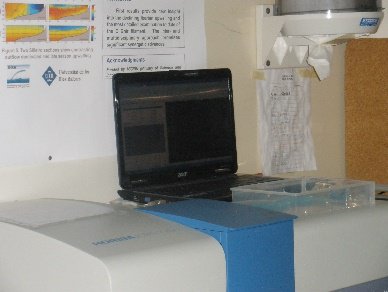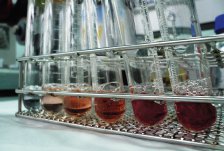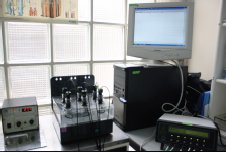Plankton Metabolism: Biochemical regulation and Oceanographic Impact in the Biological Pump (BIOMBA)
 By producing CO2, plankton metabolism acidifies the ambient seawater. It leads to the release of particulate and dissolved organic carbon and nitrogen which, in turn, augments carbon and nitrogen fluxes in the ocean. This process modulates the CO2 buildup in the atmosphere. This proposal is concerned with respiratory CO2 production, O2 consumption, and ammonium excretion, three major facets of plankton metabolism. In the respiration part of the project we aim to introduce a new oceanographic proxy: the measurement of isocitrate dehydrogenase (IDH) to detect the CO2 production rate in zooplankton, phytoplankton, and bacteria. In addition, we plan to revolutionize the assessment of the respiratory O2 consumption proxy by introducing the fluorescent electron acceptor, resazurin. This modernization of the respiratory electron transport system (ETS) assay will greatly facilitate studies of mesopelagic and abyssopelagic metabolism. Using this new assay we will investigate the relationships between ETS and IDH activities and the physiological rate of respiration and then use the results to challenge the Metabolic Theory of Ecology. In these investigations we will use gradients of starvation to force respiration and the respiratory enzyme activities (IDH and ETS) to diverge in time-course experiments. The resulting data will be used to strengthen and to challenge our mathematical model of respiration. In a similar fashion we will use our glutamate dehydrogenase (GDH) assay to investigate ammonium excretion. For the experimental work we will use cultures of a hetero trophic dinoflagellate, mysids isolated from Canary Island waters, and some new species representing phyla rarely investigated (chaetognatha, ctenophora, and urochordata).
By producing CO2, plankton metabolism acidifies the ambient seawater. It leads to the release of particulate and dissolved organic carbon and nitrogen which, in turn, augments carbon and nitrogen fluxes in the ocean. This process modulates the CO2 buildup in the atmosphere. This proposal is concerned with respiratory CO2 production, O2 consumption, and ammonium excretion, three major facets of plankton metabolism. In the respiration part of the project we aim to introduce a new oceanographic proxy: the measurement of isocitrate dehydrogenase (IDH) to detect the CO2 production rate in zooplankton, phytoplankton, and bacteria. In addition, we plan to revolutionize the assessment of the respiratory O2 consumption proxy by introducing the fluorescent electron acceptor, resazurin. This modernization of the respiratory electron transport system (ETS) assay will greatly facilitate studies of mesopelagic and abyssopelagic metabolism. Using this new assay we will investigate the relationships between ETS and IDH activities and the physiological rate of respiration and then use the results to challenge the Metabolic Theory of Ecology. In these investigations we will use gradients of starvation to force respiration and the respiratory enzyme activities (IDH and ETS) to diverge in time-course experiments. The resulting data will be used to strengthen and to challenge our mathematical model of respiration. In a similar fashion we will use our glutamate dehydrogenase (GDH) assay to investigate ammonium excretion. For the experimental work we will use cultures of a hetero trophic dinoflagellate, mysids isolated from Canary Island waters, and some new species representing phyla rarely investigated (chaetognatha, ctenophora, and urochordata).  We plan to apply and to test these laboratory advances at sea by measuring respiratory CO2 production and O2 consumption as well as NH4+ excretion in a cyclonic and in an anticyclonic gyre near Gran Canaria. The C and N flux via the biological pump will be calculated from these enzyme data.
We plan to apply and to test these laboratory advances at sea by measuring respiratory CO2 production and O2 consumption as well as NH4+ excretion in a cyclonic and in an anticyclonic gyre near Gran Canaria. The C and N flux via the biological pump will be calculated from these enzyme data.
BIOMBA is structured in 2 modules that include 3 objectives.
Module 1: Laboratory-based Experimentation
Objetive 1.- Develop a new oceanographic index for the CO2 production rate in seawater that will permit us to address important oceanographic questions such as carbon flux and ocean acidification. This proxy will use the Krebs Cycle enzyme, isocitrate dehydrogenase (IDH). In addition, we will improve the sensitivity of the oceanographic index for the O2 consumption rate. This improvement will be achieved by using a fluorometric electron acceptor (resazurin).

Objetive 2.- Impliment and explore new optode technology to measure the rates of respiratory CO2 production and O2 production in phytoplankton, bacterioplankton, and zooplankton. This will result in a new level of understanding about the relationships between the enzyme activities of IDH and ETS and the physiological rates of respiratory CO2 production and O2 consumption.
Module 2 Culture collection of experimental organisms
Objetive 3.- Enlarge our zooplankton culture collection by adding specimens from new phyla. This collection is of vital importance for our experimental work in developing ocean rate proxies (Objective 1) and in our eco-physiology research (Objective 2).







